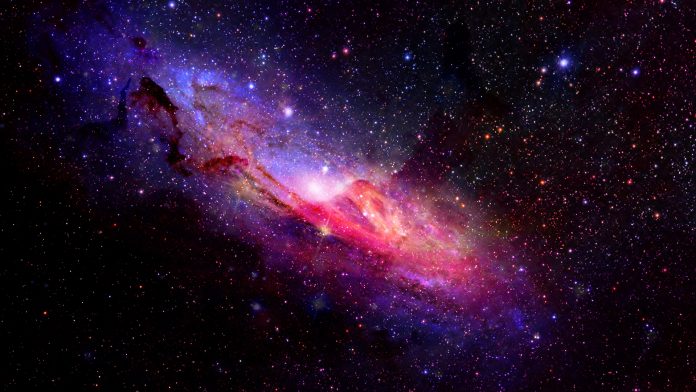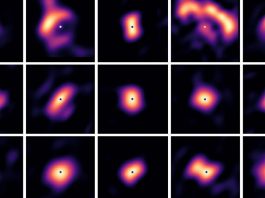Using the Atacama Large Millimeter/submillimeter Array (ALMA) and the gravitational lens effect, astronomers have discovered a rotating infant galaxy.
The infant galaxy found by the astronomers is 1/100th the size of the Milky Way at a time when the Universe was only 7% of its current age.
Using the gravitational lens effect enabled the team to explore nature of small and dark “normal galaxies” in the early Universe, illustrative of the main population of the first galaxies, which significantly improves scientists’ understanding of the early phase of galaxy evolution.
“Many of the galaxies that existed in the early Universe were so small that their brightness is well below the limit of the current largest telescopes on Earth and in Space, making difficult to study their properties and internal structure,” explained Nicolas Laporte, a Kavli Senior Fellow at the University of Cambridge. “However, the light coming from the galaxy named RXCJ0600-z6, was highly magnified by gravitational lensing, making it an ideal target for studying the properties and structure of a typical baby galaxies.”
Gravitational lensing is a natural phenomenon where light released from a far away object is bent by the gravity of a massive body such as a galaxy or galaxy cluster in the foreground.
The ALMA Lensing Cluster Survey (ALCS) team utilised ALMA to look for a large number of galaxies in the early Universe that are enlarged by gravitational lensing. Using a combination of the power of ALMA, with the help of the natural telescopes, the researchers are now able to discover and study fainter galaxies.
Studying the faintest galaxies in the early Universe is significant as dominant theories suggest that most of the galaxies formed in the first few hundred million years after the Big Bang are small, and therefore faint.
While numerous galaxies in the early Universe have previously been studied, those explored were restricted to the biggest objects, and consequently the less representative galaxies, in the early Universe, because of telescopes capabilities. Therefore, the only way to comprehend the typical formation of the earliest galaxies, and acquire a complete understanding of galaxy formation, is to focus on the fainter and more numerous galaxies.
The large-scale observation programme undertaken by the team took 95 hours. During their observations, the team discovered a distant galaxy being influenced by the gravitational lens created by this natural telescope.
ALMA discovered the light from carbon ions and stardust in the galaxy and, along with data taken with the Gemini telescope, concluded that the galaxy is observed as it was about 900 million years after the Big Bang. Further examination of the data indicated that a part of this source is seen 160 times brighter than it is intrinsically.
By measuring the distribution of the cluster of galaxies, it is possible to bring back the original appearance of the magnified object. Using a combination of data from Hubble Space Telescope and the European Southern Observatory’s Very Large Telescope with a theoretical model, the group was able to reconstruct the shape of a distant galaxy named RXCJ0600-z6.
The RXCJ0600-z6 galaxy is rotating, which defies the typically understood behaviour of infant galaxies, which is though to be more random and chaotic in motion.
ALMA discovered several rotating infant galaxies that have contested the conventional theoretical framework, but these were larger than RXCJ0600-z6.
“Our study demonstrates, for the first time, that we can directly measure the internal motion of such faint (less massive) galaxies in the early Universe and compare it with the theoretical predictions”, commented Kotaro Kohno, a professor at the University of Tokyo and the leader of the ALCS team.
“The fact that RXCJ0600-z6 has a very high magnification factor also raises expectations for future research,” added Seiji Fujimoto, a DAWN fellow at the Niels Bohr Institute. “This galaxy has been selected, among hundreds, to be observed by the James Webb Space Telescope (JWST), the next generation space telescope to be launched this autumn. Through joint observations using ALMA and JWST, we will unveil the properties of gas and stars in a baby galaxy and its internal motions. When the Thirty Meter Telescope and the Extremely Large Telescope are completed, they may be able to detect clusters of stars in the galaxy, and possibly even resolve individual stars. There is an example of gravitational lensing that has been used to observe a single star 9.5 billion light-years away, and this research has the potential to extend this to less than a billion years after the birth of the Universe.”









